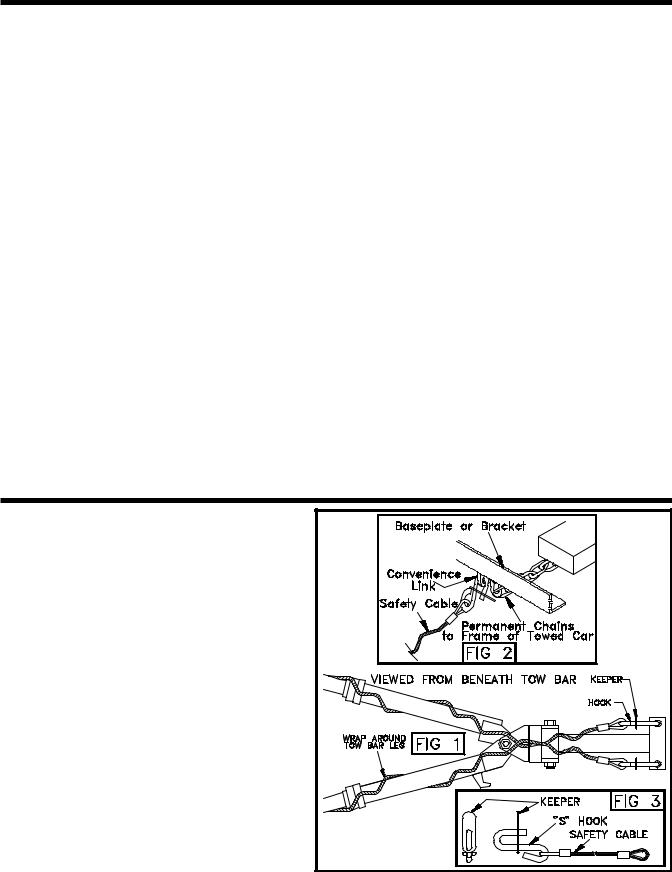Blue Ox BX7330 User Manual

TM
A V E N T A
OPERATOR, PARTS AND
INSTALLATION MANUAL
BX7330
A V E N T A TM |
Tow Bar |
TOWING PRODUCTS DIVISION

SAFETY
DO NOT INSTALL, OPERATE OR USE THIS EQUIPMENT UNTIL THE FOLLOWING OPERATING AND SAFETY INSTRUCTIONS HAVE BEEN READ AND UNDERSTOOD.
This symbol is used to bring attention to safety precautions and instructions. When you see this symbol, be alert and pay attention to all instructions. YOUR PERSONAL
SAFETY IS INVOLVED.
1.Blue Ox Tow Bars are designed to tow manual transmission cars or automatics equipped with a transmission pump, drive shaft disconnect or half shaft disconnect.
2.The transmission is in neutral when towing.
3.Unlock the steering wheel to allow the front wheels of the towed vehicle to “track”.
4.Be sure the front end of the towed vehicle is properly aligned.
5.The use of safety cables or chains is REQUIRED BY LAW. Model BX8805 (5ft) or BX8806 (6ft) cables are recommended. The shorter BX8805 is normally best.
6.Check clearance between vehicles in a turning situation.
7.Most States require rear lighting on the towed car. A BX8811 Wiring Kit or BX8834 Light Bar is recommended.
8.Prior to a towing trip, check to be sure all the towing accessories and attachment points are secure. Check for cracked welds and loose bolts. This is important on all occasions, but particularly on a new installation, when they should be checked just prior to initial towing and again after 100-200 miles of towing.
9.Do Not Back Up when towing. Backing up may damage the Tow Bar Assembly, towing vehicle's chassis or towed vehicle's chassis.
10.Avoid sharp turns and rough terrain. Check installation after any unusual event and periodically on a long trip.
11.Do not use the Towed Vehicle for storing luggage, etc.; you may exceed the towing capacity of the Tow Bar.
SAFETY CABLE INSTALLATION
1.Using the cable hooks, attach the cables to a solid part of the chassis of the towed vehicle or to the baseplate convenience links on unibody cars. Slip the end of the S-hook through the neoprene keeper to prevent it from unhooking. (See Fig. 3)
NOTE: It is best to have permanent chains that connect the convenience links to the frame of the car. (See Fig. 2)
2.Wrap each cable once or twice around their respective tow bar leg and cross them under the receiver area. (See Fig. 1)
3.Using the S-hooks, attach the opposite ends of the cables to a solid part of the chassis of the towing vehicle if at all possible. Slip the end of the S-hook through the neoprene keeper to prevent it from unhooking
(See Fig. 3)
4.Adjust slack so that the cables cannot touch the ground or become caught beneath the receiver. If either of these things happen, the cables may become damaged and ineffective. DO NOT USE DAMAGED CABLES!
5.If BX8805 or BX8806 cables are not used, be sure EACH cable or chain used has at least the load rating of the tow bar (5000 lbs.).
292-1661 2/96 1 of 6

INSTALLATION / HOOKING UP
TOW BAR INSTALLATION
 CAUTION: As with any mechanical product, care should be taken during installation and operation, to prevent your fingers from being pinched.
CAUTION: As with any mechanical product, care should be taken during installation and operation, to prevent your fingers from being pinched.
1.Slide the receiver connector into the receiver tube of your towing vehicle hitch. Secure it with the
receiver pin provided. (Figure 1)
NOTE: The configuration of the rear of your towing vehicle will determine how far you can slide it into the receiver. Later, when the tow bar is folded, you may need to change which set of holes is used in the receiver connector.
2.Proceed with hooking up towed vehicle.
3.DEALER OR INSTALLER: BE CERTAIN USER
RECEIVES INSTRUCTION SHEETS. |
Figure 1 |
HOOKING UP (Towed Vehicle)
1.Position the towing vehicle on a level surface with approximately 100 ft. to 200 ft. of straight driveway ahead and engage the parking brake. (Later, You will be driving straight ahead to latch the legs when extending the tow bar.) Position the towed vehicle behind the towing vehicle in the approximate towing position and engage the parking brake of the towed vehicle.
NOTE: Replace wire lock pin into fold up tabs and lock in place to avoid losing pin.
3.Unlock one of the leg latches and partially extend the leg.
NOTE: Leg latches are unlocked by sliding the collar back to expose the red rubber seal under the collar. (Figure 3)
4.Refer to figure 4 on page 3. Place the baseplate connector between the baseplate attachment tabs on the towed vehicle and secure with the connector pin tethered to the leg. Be sure to place the quick pin, also tethered, through the hole in the connector pin to lock it in place. The quick pin only locks when the ring is rotated towards the nose of the quick pin. Repeat for both legs.
Figure 2
2.Face the folded tow bar on the rear of the towing vehicle. (Figure 2) Remove the wire lock pin from the tow bar fold up tabs. Unfold the tow bar by raising the tow bar legs until the retainer pin clears
the slot in the pivot bracket. Pull the legs out |
|
|
away from the towing vehicle and place them on |
Figure 3 |
|
the ground. |
||
|
292-1661 2/96 2 of 6
